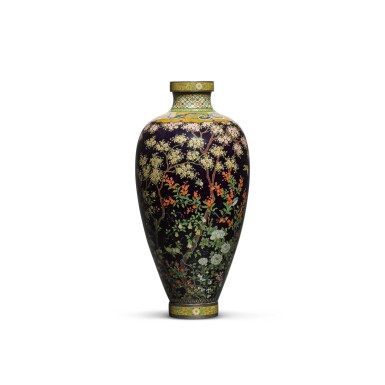Masters of Enamel: The Collection of John and Muriel Okladek | Including Further Japanese Works of Art from the Meiji Period, 1868-1912
Masters of Enamel: The Collection of John and Muriel Okladek | Including Further Japanese Works of Art from the Meiji Period, 1868-1912

Property from the John and Muriel Okladek Collection
A fine cloisonné enamel vase | Signed on a silver tablet Kyoto Namikawa (workshop of Namikawa Yasuyuki, 1845-1927), but attributed to Shibata | Meiji period, late 19th century
Lot Closed
November 3, 02:12 PM GMT
Estimate
150,000 - 180,000 GBP
Lot Details
Description
Property from the John and Muriel Okladek Collection
A fine cloisonné enamel vase
Signed on a silver tablet Kyoto Namikawa (workshop of Namikawa Yasuyuki, 1845-1927), but attributed to Shibata
Meiji period, late 19th century
the oviform vase with short tapered foot and everted neck, silvered mounts, finely decorated in various coloured enamels and thicknesses of silver wire, with sparrows, finches and butterflies among a profusion of flowers and trees in bloom, including cherry, magnolia, hydrangea, chrysanthemum, irises and wild pinks, the shoulder with archaic dragons and birds on an ochre ground, and bands of ivy and karakusa, hanabishi on a yellow ground, the foot with flowerheads and further karakusa, the lip and rim similarly decorated, signed on a silver tablet Kyoto Namikawa (workshop of Namikawa Yasuyuki, 1845-1927)
19.5 cm., 7¾ in. high
The Ahrens Company was one of many companies set up under the new Meiji government’s programme whereby western specialists were invited to Japan to help modernise the country’s existing industries. Their chief technologist was the German chemist Gottfried Wagener (1831–92). Wagener, an expert on glazes and firing techniques, is renowned for having introduced modern European enamelling technology to Japan.
In 1878 Wagener moved to Kyoto where he met the former samurai turned cloisonné artist Namikawa Yasuyuki (1845-1927). Yasuyuki began his career around 1868 and worked with the Kyoto Shippo Kaisha from 1871 to 1874. Although it is not clear how Wagener and Yasuyuki met, there is no doubt that they collaborated and that the most significant result of their collaboration was the creation of the superb semi-transparent mirror-black enamel that was to become the hallmark of much of Yasuyuki’s subsequent work.
Yasuyuki’s cloisonné enamels are characterised by the skilful use of intricate wirework and superb attention to detail. The designs on his earlier pieces are relatively traditional, consisting mainly of stylised botanical and formal geometric motifs. The designs on much of his later work tends to be more pictorial, consisting mainly of scenes from nature and views of landmarks in and around Kyoto. His work included both pieces with designs predominantly defined by wires and pieces where the pictorial composition is balanced by large areas of pure coloured enamel.
